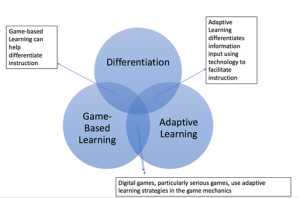5 Differentiated Instruction
Carrie Lewis Miller
Learning Objectives
- Explain Adaptive Learning
- Recommend Adaptive Learning Solutions for your own organizational context
- Identify tools for use to create adaptive learning experiences
- Create a -Mini Adaptive Learning Experience
- Plan multiple methods of creating adaptive learning experiences
Differentiated instruction is a method that allows instructors to create avenues to learning content and assessment that speak to individual differences between students. In order to differentiate instruction and assessment, instructors or trainers must fully understand each student and their learning preferences. The idea behind differentiation goes back to the notion of personalized pathways to learning. Differentiation, unlike Adaptive Learning, doesn’t necessarily require the use of technology to be implemented. Yet, like adaptive learning, differentiation is about information input and providing multiple approaches to exploring content.
By using Bloom’s taxonomy to help design content exploration activities and assessments, instructional designers can offer learning experiences at multiple cognitive domains. For example, going back to our Henry VIII example, some differentiated activities for exploring the content might include:
- Ordering a list of Henry VIII’s wives from first to last
- Reading a text or watching a video about Henry’s wives and responding to questions
- Creating a Tudor family tree
- Presenting a summary of each wife and the political implications of each marriage to the monarchy
Differentiation also focuses on providing multiple avenues of information input. Giving students the opportunity to learn according to their learning preference can increase their motivation and engagement with the content. Providing the same or similar information via text, video, lecture, and/or interactive elearning module creates options for learners to satisfy and perhaps strengthen their multiple intelligences (Gardner, 2008).
When it comes to assessment, differentiation means offering learners multiple methods of expressing what they know. Aligning the assessments to the learning objectives is vital, but the format of the artifact a student produces can take many forms. Moving beyond essays and presentations both encourages student creativity and provides the learner with a more definitive demonstration of their skill or knowledge.
Differentiated Instruction is at the heart of adaptive learning, which is in turn, often an integral part of Game-Based Learning. At the core of each is the concept of personalizing and individualizing instruction in order to give the learner the best learning experience. The relationship between Differentiation, Adaptive Learning, and Game-Based Learning is illustrated in Figure 4 below.

Figure 4: Venn Diagram of the overlap and differences of differentiation, adaptive learning, and game-based learning.
References
Gardner, H. E. (2008). Multiple intelligences: New horizons in theory and practice. Basic books.
Recommended Supplementary Material
- Taylor, B. K. (2015). Content, process, and product: Modeling differentiated instruction. Kappa Delta Pi Record, 51(1), 13-17. https://doi.org/10.1080/00228958.2015.988559
- Jennifer Gonzalez and Tracy Enos: Using Playlists to Differentiate Instruction

